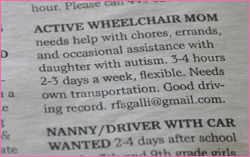 This column was originally published as part of my “Tuesdays with Madison” series at AutismAfter16.com.
This column was originally published as part of my “Tuesdays with Madison” series at AutismAfter16.com.
It’s that time again. Time to replenish the reservoir of talented folks who help me manage life—mine and Madison’s, my 20-year-old daughter with autism.
I have the process down to a science. Over the last 25 years, I’ve hired 72 caregivers for our family. Some helped me part-time for only a few weeks. Others I’ve seen graduate from college, get married, and have their own kids. One has been with me 19 years.
Many remain Madison fans, still close to our family.
But even with such success behind me, restarting a search for good care can be daunting. The process I’ve created lessens the anxiety, but not the vigilance.
I usually start with an ad in the local college newspaper. Although the same ad is online, the applicants tell me the print ad is still the most effective. The ad needs to target both the core responsibilities and the environment, clearly stating any requirements.
After a swap of email addresses and a few phone calls, I ask each applicant to fill out a four-page questionnaire I’ve devised that captures the details I want to know.
It’s difficult, I’ve learned, to interview face-to-face and remember to ask about all the details that matter.
But first, I had to take the time to decide what did matter.
From my recruiting days at IBM back in the 1980s, I learned the importance of constructing “job-relevant” criteria.
What is the job? What are the skills needed to do it well? The more specific I can be about my needs, the better and faster I can screen the applicants.
As one colleague shared with me years ago, hiring is about three elements: Can Do, Will Do, and Fit. The selection process should be designed to pull out that information.
The “Can Do” translates into an Experience/Education section on the questionnaire. Designed to probe job-relevant specifics, it contains questions like, “Have you worked with children with special needs?” And, “What child-related education/classes have you had?”
As for “Will Do,” checklists help.
“Check if you are willing to do or assist with,” that section begins. Ten to 15 duties are listed, from running carpool, meal prep, and helping with homework to scooping out the kitty litter. (I rarely ask anyone to scoop the kitty litter, but I want to know if they are willing to do it!)
As for “Fit,” I use several open-ended questions: “What do parents like most about you?” “What do children like most about you?” Then I conclude that section with another checklist where applicants self-assess on a 10-point scale attributes such as timeliness, initiative, organizational skills, and tidiness.
Then, of course there are the references, availability, and wage questions.
But the most important question, I save for the interview:
“Have you worked with children who have difficult behaviors?”
The reaction to this question is a critical.
The answer is not as important, however, as is the way it is answered—the confidence, tone, and the manner the applicant speaks about the topic. Most often, I make my hiring decision based on this discussion.
The best caregivers have been those that possess a quiet, observant demeanor, and are quick to learn. And being tough, mentally and physically, is a big plus, too.
For on occasion, my sweet missy Madison can be a little unpredictable, challenging her caregivers.
There was the time she realized the sitter was upstairs and promptly shut the door on me in the bathroom, bolting out the back door to the local school playground. Or the time she tried to climb out the second story window when the sitter caught her half way out. Or the time she had an upset in Wal-Mart that prompted one shopper to ask my sitter, “Do you need my belt?”
Over time, the caregivers learn how to anticipate Madison’s moods and needs.
The challenge for me is to continue to accurately anticipate mine as she moves into adulthood.
Follow Me!